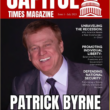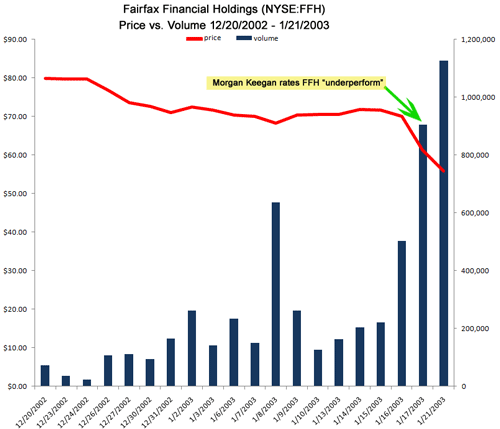Fairfax Financial Holdings (NYSE:FFH) was first listed on the NYSE on December 20, 2002. During its first 15 trading days there, volume averaged well under 180,000 shares.
Then, on January 16, 2003 FFH volume exceeded 500,000 shares on an otherwise uneventful day in the life of a Canadian insurance company.
The next day, January 17, 2003 Morgan Keegan analyst John Gwynn initiated coverage of FFH with a scathing report and rating of “underperform”, making for one of the more eventful days in the lives of Fairfax shareholders, as their investments took heavy losses on extremely high volume.
Because information drives markets, one would expect to see extra activity in the wake of new information, such as that introduced by Gwynn on the 17th.
But what accounts for the unusually high volume observed the day before Gwynn’s report was published?
The answer to that question would come in October of 2008, when Morgan Keegan announced that Gwynn had been terminated for sharing his unpublished research on Fairfax with a small group of short-selling hedge funds.
Thanks to email messages and trading data recently obtained through discovery in the Fairfax Financial vs. SAC Capital, et al, lawsuit, we know that hedge funds Kynikos Associates, Third Point Capital, and SAC Capital all traded ahead of this material, non-public information. According to legal briefs filed by Fairfax Financial, Rocker Partners (later Copper River Partners) did as well (Rocker Partners denies this, while fighting manfully to prevent disclosing the trading records that would establish the truth, one way or the other).
Trading on material, non-public information, dear readers, is illegal.
In attempting to unravel how all this came about, one hedge fund name appears over and over: Kynikos Associates, run by James Chanos, who also serves as Chairman of the Coalition of Private Investment Companies, the hedge fund industry’s Washington DC lobbying organ.
It started on December 11, 2002 when Kynikos employee Mark Heiman alerted Chanos that he had just learned from an analyst at Ziff Brothers Investments that a Morgan Keegan analyst was about to publish a negative report on Fairfax.
From: Mark Heiman
Sent: December 11, 2002 11:06 PM
To: James Chanos; Douglas Millett
Subject: Fairfax
I just got off the phone with ZBI’s insurance analyst, Michael Ting. He just talked to a new insurance analyst at Morgan Keegan, and apparently that analyst is about to initiate FFRX at “Underperform,” with the thesis being that they are extremely under-reserved into the $3-$5 BN area. Also, there may be an article in Forbes or Fortune soon that will be similarly critical.
Ting said he thought that analyst was one of the best P&C analysts he has talked to, and wanted to give us the heads-up, as well as hear how we’re coming at it.
The next day, Kynikos employee Matt Cantrell apparently contacted Gwynn, as he sent Ting several documents relating to Fairfax subsidiaries, with the comment, “John Gwynn believes these might be of interest to you.”
Four days later, Heiman spoke to Gwynn personally, having a conversation which he summarized in the following report to Chanos:
From: Mark Heiman
Sent: December 16, 2002 4:46 PM
To: James Chanos; Douglas Millett; Charles Hobbs
Subject: Fairfax
Just spoke to John Gwinn at Morgan Keegan, and he was more critical of FFRX than I’ve ever heard a sell side analyst. It looks like his criticisms of from the top to the bottom–everything from underwriting to accounting to dishonesty. He gave me his basics, as he is somewhat restricted because he hasn’t officially launched. It will be interesting to see how much of this the people who run the research department there will let him publish!
On December 18, 2002, Chanos forwarded Heiman’s email to Jeff Perry, then an analyst at SAC Capital.
The day after Fairfax began trading on the NYSE, Gwynn’s revelations became much more explicit as he shared with Kynikos employee Heiman portions of his forthcoming report on Fairfax.
From: Mark Heiman
Sent: December 21, 2002 6:03 PM
To: James Chanos; Douglas Millett; Charles Hobbs
Subject: Fairfax
Last night John Gwinn at Morgan Keegan faxed over to me an outline detailing the issues at FFH, basically those he will be publishing on. He has been a huge help and even offered to talk to me from his home today. We can look at these and talk to him next week–I just wanted to come in today and take a look at what he sent to get a head start on what he sent.
In the days to follow, Gwynn and SAC Capital Portfolio Manager Forrest Fontana held a face to face meeting where they discussed Fairfax.
Fontana followed up on that meeting via email to Gwynn:
From: Forrest Fontana
Sent: January 06, 2003 8:57 AM
To: John Gwynn
Subject: RE: hope you had a nice holiday!
you available to touch-base on Fairfax sometime this week?
Followed by Gwynn’s prompt and eager reply:
From: John Gwynn
Sent: January 06, 2003 9:01 AM
To: Forrest Fontana
Subject: RE: hope you had a nice holiday!
Name the time.
Fontana proposed a conversation the following day and requested a spreadsheet summarizing Gwynn’s analysis on Fairfax, which Gwynn promised to send.
On January 13, 2003 Fontana sent his boss, Steven A. Cohen himself, a summary of his planned activities for the week, which included:
Tuesday 1/14: Morgan Keegan expected to launch on Fairfax with sell rating – we will be covering into this.
As it turns out, Gwynn’s report was published on the 17th of January, not the 14th as Fontana expected. Still, it’s clear that SAC Capital was formally planning to trade ahead of the information received by Gwynn.
Trading records produced by Kynikos and Third Point all tell the same story: heavy short selling in anticipation of Gwynn’s report, and highly profitable short covering in the days that followed.
What did John Gwynn get out of all this? That’s unclear, though upon his firing, Morgan Keegan went to great lengths to say that Gwynn’s opinions were his own and not influenced by the hedge funds that profited from advance knowledge of them.
The next question is: did Morgan Keegan get anything out of this arrangement?
The answer is yes: On December 21, 2002, the day after Kynikos received Gwynn’s unpublished analysis, Kynikos money manager Douglas Millett declared his intention to begin sending business to Morgan Keegan.
Apparently, that’s how big hedge funds like Kynikos operate, which makes Kynikos President James Chanos the logical person to represent his peers before Congress as that body considers long-overdue reforms.
Addendum: today (January 9, 2009) I received a letter from the attorney of Rocker/Copper River Partners protesting my suggestion that the firm was among those trading ahead of the Morgan Keegan report on Fairfax referenced above. In short, Rocker says the analysis was released on January 16, 2003 and their short position established the following day. The story has been slightly edited to reflect their position. I am currently examining the specifics of Rocker’s objections — though find that difficult given Rocker’s attorneys have taken steps to keep sealed what they insist is exculpatory evidence — and will return to this issue shortly.
If this article concerns you, and you wish to help, then:
1) email it to a dozen friends;
2) go here for additional suggestions: “So You Say You Want a Revolution?“









Watch this disgusting slobber:
http://www.cnbc.com/id/15840232?video=956266043&play=1
Now, tell me why CNBC should be on the air.
See you in Church, Judd. Thanks a ton. Now, let’s see justice done.
So, what do we need now? A new Department of Justice? Is there one available? Kynikos up 50%? When Chanos should be in jail. I wonder what that would do to his redemptions? Don’t let up guys. Keep the pressure on. Any word from Fortune Magazine, yet?
Judd, I wonder why the SEC never uncovered any of these e-mails that Fairfax has uncovered. Could this be Madoff all over again whereby the SEC goes in, talks nice to these fund managers, and walks away without conducting and valuable independent research into fraud allegations. certainly there has been enough written into the papers to have the SEC question these funds and yet they pulled a Madoff and let the scam continue.
I wonder, how much of Chanos and Cohens performance is based on such fraud? you don’t have to be smart when you have the inside scoop.
http://thesanitycheck.com/BobsSanityCheckBlog/tabid/56/EntryID/737/Default.aspx
Oh yeah. When? when?
check this out. Einhorn is saying, along with a Vanity Fair columnist, that Investment Professionals should have a place as SEC commissioners.
http://www.nytimes.com/2009/01/04/opinion/04lewiseinhornb.html
You do have it to hand it to them. “Shame” is not in their dictionary.
The current brass at the SEC, DTCC and the Scumbags running the crooked hedgefunds should all be in jail and tried for treason for bringing this country to it knees.
I think we need a organized campaign of e-mails to specific targets and news papers as well as the FBI.
rtway, i have literally 1000’s of e-mails i have sent to news agencies senators congress fbi homeland security secret service etc etc etc phone calls as well i have made to the federal law enforcement agencies all every last one have been in vain. the sob’s simply dont give a rip about you or the rest of america. i wish my experience had been different. heck i have a letter from sen cantwell thats says it aint her job.
which takes me to the next step of filing a formal complaint against her. what else can you do?
here is the e-mail i got from the ago
Mr. Brandom –
Thank you for your recent email to the Attorney General’s Office in which you request information on how to file a formal complaint on your bankruptcy attorney and Senator Cantwell.
All complaints regarding attorneys licensed to practice law in the State of Washington are handled by the Washington State Bar Association. You can contact that agency directly by either writing to them or by accessing their website at http://www.wsba.org or at their physical address: Washington State Bar Association, 2101 Fourth Ave., Ste. 400, Seattle, WA 98121-2330. On the WSBA’s website you can search “grievance” and file a complaint with them through that channel.
I was not able to find a definitive place to file a complaint against a US Senator, however, you may wish to contact the US Senate at United States Senate, Washington, D.C. 20510 or via phone at (202) 224-3121.
The Attorney General’s Office does not have original investigation authority or jurisdiction regarding private matters related to conduct of private attorneys. This office is authorized by law to provide advice only to state agencies and certain state officials. By law, we are not authorized to provide advice to private citizens and/or companies. Consequently, the above information is of a general nature and should not be construed as an official opinion of this office or of the Attorney General.
I hope this information proves helpful. Thank you again.
La Dona Jensen
Director of Public Records
& Constituent Services
Attorney General’s Office
[email protected]
Harv,
In view of the Madoff scandal it might be easier to get the attention of the press as it is an easy story all the work has been done all they need is a new scandal. If not go to other extremes.
Dear
You write: “I think we need a organized campaign of e-mails to specific targets and news papers as well as the FBI.”
Just in case you’re a newcomer, and missed this post from July, 2008. It will take some of the effort out of creating such a campaign.
https://www.deepcapture.com/so-you-say-you-want-a-revolution/
Patrick
lenofus — The NYT article by Michael Lewis and David Einhorn is puzzling.
I would not expect to see those two linked. That’s curious.
I don’t know how to interpret the recommendation of Harry Markopolos for Chief of Enforcement at SEC. That’s not altogether a bad idea, right? Nut I would of course prefer maybe Gary Aguirre or Patrick Fitzgerald.
Money As Debt:
http://video.google.com/videoplay?docid=-9050474362583451279
the founders figured this one out without the benefit of a video…
Don’t mind that man behind the curtain!
and just to show this is sop:
Copyright © 2000 Dow Jones & Company, Inc. All Rights Reserved.
SEC Probes a Well – Timed Trade
—
Records From Hedge-Fund Trader
Show Short Sale of Amazon.com
Before Fiancee Issued Downgrade
By Randall Smith
02/05/2003
The Wall Street Journal
Page C1
(Copyright (c) 2003, Dow Jones & Company, Inc.)
MICHAEL ZIMMERMAN, hedge-fund investor and husband of Lehman Brothers’ star Internet analyst Holly Becker, was betting that the stock price of Amazon.com Inc. would decline the day before Ms. Becker downgraded the stock in July 2000, contributing to a price drop, according to stock-ownership records.
Although the size of the bet was a relatively small 95,000 shares, enough to reap the hedge-fund trading account a one-day paper profit of about $148,000, the trade is among the activities being scrutinized by regulators as they consider whether to pursue possible insider-trading charges against the couple, according to one person familiar with the probe.
The Securities and Exchange Commission has been examining whether Mr. Zimmerman may have improperly exploited knowledge of coming stock-research calls from Lehman, a unit of Lehman Brothers Holdings Inc., which he might have obtained via Ms. Becker. At the time, Ms. Becker was his fiancee; he married her in August 2000. Although some news reports have indicated the SEC won’t proceed with any charges against the couple, a person familiar with the matter says the inquiry remains open.
The SEC’s probe is one of several by various regulators into the activities of hedge-fund managers. New York State Attorney General Eliot Spitzer, for example, is examining whether Gotham Partners Management Co. (unrelated to Gotham Capital LLC) acted improperly in publishing a bearish research report on MBIA Inc. as part of an effort to drive down the price of the stock and bonds of the insurer, on which Gotham had placed bearish bets.
In some of the inquiries, regulators are seeking to learn if hedge funds may have used stock research, or advance word of research reports, to make money on their own trades. Once the exclusive preserve of the super-rich, these largely unregulated investment pools are increasingly marketing themselves to battered Main Street investors who are seeking alternatives to the stock market.
The account records of SAC Capital Advisors indicate that Seth Kanegis, then Mr. Zimmerman’s trading partner at the hedge fund, was “short” 95,000 Amazon shares at the end of the day on July 25, 2000, the day before Ms. Becker’s downgrade. In a short sale, an investor sells borrowed shares, aiming to profit by buying them back more cheaply after the price declines. Such short sales are commonplace for most well-known stocks in the market.
On the morning of July 26, Ms. Becker issued a report titled “Throwing in the Towel on Amazon,” in which she downgraded the stock to “neutral” from “buy.” The change, Ms. Becker said, reflected Amazon’s “lack of traction” in expanding beyond its core bookselling business, “softness in key consumer metrics” such as customer turnover, and “execution risk” stemming from cost cutting.
The report — together with news of the resignation of a top Amazon executive — helped send the stock down $1.56, or 4.2%, to $36.06 that day on the Nasdaq Stock Market. At the end of the day on July 26, the SAC account records indicate that the Kanegis-Zimmerman trading account, or “pad” as it is known internally, had closed out the short position by buying back the Amazon stock. Since the trading prices of the short sale aren’t available, the traders’ precise profit or loss on the transaction couldn’t be determined.
That same short position, however, would have generated considerably larger profits had the SAC traders held it one more day. On July 27, the stock tumbled an additional $4.69 to $31.38 after Amazon reported shortly after the market closed July 26 that its sales had fallen short of expectations in the second quarter.
A spokesman for the SEC declined to comment. Mr. Kanegis referred calls to the in-house lawyer at SAC Capital, Peter Nussbaum, who declined to comment. David Brodsky, a lawyer for Mr. Zimmerman and Ms. Becker, also declined to comment.
Mr. Kanegis’s role in Mr. Zimmerman’s trading hasn’t been reported. A veteran trader at SAC, which has offices in Manhattan and Stamford, Conn., Mr. Kanegis worked with Mr. Zimmerman for at least some of the time that the SEC is scrutinizing as part of its insider-trading probe. SAC’s chief is Steven A. Cohen, one of the top traders on Wall Street, whose returns have beaten the market so consistently that his investors allow him to keep half the profits instead of the usual 20%.
A flamboyant party-giver, Mr. Kanegis threw a theme party based on Amsterdam’s red-light district at his home in Bedford, N.Y.; the event was was featured in the Sunday Styles section of the New York Times in January 2000. He was co-executive producer of an independent movie released in 2000 called “Two Ninas,” featuring actress Amanda Peet. Colleagues say he is also a big contributor to the Wyclef Jean Foundation, formed by the hip-hop artist to provide musical instruments, lessons and therapy for children. Mr. Jean performed at the Amsterdam-theme party.
However, Mr. Zimmerman cut his economic ties to Mr. Kanegis while remaining at SAC after seeking to join one or more other hedge-fund managers in early 2001, according to colleagues. Although Mr. Zimmerman raised the possibility of leaving SAC completely, people familiar with the events said that Mr. Cohen blocked his departure by threatening to invoke a noncompete provision in his employment agreement with SAC.
Mr. Zimmerman — who formerly worked at the Lazard Asset Management unit of Lazard LLC as well as at Omega Advisors, a hedge fund run by Leon Cooperman — is an expert on investing in retailing stocks. His father, Ron Zimmerman, works in institutional sales at the Sanford C. Bernstein unit of Alliance Capital Management Holding LP.
The SEC’s probe, which is roughly two years old, was initially conducted by a regional office in Utah, then referred last year to agency headquarters in Washington.
Just heard on news where the victims (uber Rich) of Madoff scheme are demanding a Government bailout. Imagine that. We have been ripped off several times in the market by scam companies or naked short sellers and of course no bailout for us…..
We can kiss Capitalism goodbye in the near future.
Would some please explain this to me?
Why was Patrick Byrne treated like a piece of shit when he came on CNBC and Einhorn, Chonos, Greenberg et al where all treated like kings?
No low level host on TV treats someone with such distain unless it comes from the top.
This ain’t finished yet!
lenofus, isn’t Seth Kangis the very same that plays around in Miami with penny stock promoter and fellow party man Jamie Goldberg? If I am not mistaken the duo has a history of extorting shares out of small companies they befriend and then hold up. Goldberg, the broker, was listed in the court documents of Richard Altomare as receiving shares of USXP during the massive stock distribution campaign Altomare engaged in. Goldman, with Kangis, likewise extorted both money and stock out of Jag Media. They prey on small companies without the finances to fight the legal battles. When you hear about how Cohen runs his fund you must assume the dirty tactics were part of the SAC training program.
Would some one also kindly explain this to me.. Why has the authorities not arrested these criminals for their blatant illegal activites but are going after the little people involved in other ponzi schemes like the 23million dollar one in south florida going after Haitian American investors? It would seem as if our Regulatory Agencies have been told to steer clear of the “Big Criminals” and bring down the little fish only. Oh and where has Herbie been lately? Anyone seen or heard of him? Jail could’nt be too far behind. If they catch him he will squeel like a little sow!!! Mark my words.
Sean,
It took a while for the answer to sink in to my stubborn brain. I wanted to believe the “authorities” want to enforce the law. I could not understand that they really don’t want to. They have other priorities. That’s what is so hard to accept for so many of us. We don’t want to believe the corruption has penetrated so deep.
Drop the link to this evidence at:
https://tips.fbi.gov/
And send it to the SEC tip line ( http://www.sec.gov/complaint.shtml ) and the usual media suspects.
There will be a trail of notification and as usual, the ignoramuses can’t plead ignorance. Of course they’ll ignore it, but that’s the M.O.
When reading about rogues in the news, I like to check out their political contributions to find out where the money goes. This links shows contribs from James Chanos.
http://fundrace.huffingtonpost.com/neighbors.php?type=name&lname=Chanos&fname=James
Draft a memo to the SEC and ask why these e-mails never surfaced in the SEC investigations into Chanos and Cohen once Fairfax filed a complaint against them?
This looks amazingly like Madoff and Mack all over again. Soft SEC investigations into connected firms and individuals.
The list to send it to would be:
[email protected]
[email protected]
[email protected]
[email protected]
[email protected]
[email protected]
[email protected]
[email protected]
[email protected]
From the http://www.thesanitycheck.com
I hate to sound like a broken record but somewhere along the line we have to have a million investor march campaign or a well orchestrated simultaneous demonstrations at all the key cities to garner enough press to make it onto prime time where the media has to cover it. In light of Madoff there probably will be many people wanting this coverage. A big protest in front of CNBC co-ordinated with an interview with Patrick on Fox would be nirvana. Maybe another full page ad like the old NCANS days. We have a lot more followers to drop a few scheclkles in the pot. We could call it dollars and dimes to stop the wall St. gangsters.
Patchie,
You mention Jamie Goldberg, Miami broker. Would you know if he was the one who used to post on RB under the alias of duedillinger?
Thanks
I agree with rtway and others. We need to get organized and speak in a unified way to force our government to enforce our laws.
Ron, DueDillinger was an insecure guy in New Jersey but was not Jamie Goldberg. DD ran a small map company in NJ and worked out of his house. can’t recall the name although it was close to Goldberg.
Jamie Goldberg was a broker who loved his drugs and his strip joints. Married a stripper if I am correct.
On the Wall Street Elite….
“The sense of entitlement that everybody has because nothing has gone wrong for them is frightening to me.”… Jim Chanos source: NY Magazine Dec 7th.
After reading DeepCapture, he changes his tune to, “Everyone senses the wrong, entitlement gone… nothing for me. Frightening!”
All that the Fed’s have to prove is a pattern of front running and it becomes a criminal enterprise and they take it all. HIs investors. may lose it all… even the 50% profit….
Thanks Patchie, I go info several years ago that DueDillinger was named goldberg so I asked him with a little ditty on the Raging Bull DTMG borad where he was bashing. The ditty did not ask directly buy throgh a riddle so that he would understand what I was asking as the name Goldberg was included in a round about question he got.
Within less than a hour I got a RB email saying I was to have my posting privilages suspended for two weeks. Almost before I could read the first bRB email I got another saying it was for thirty days.Then in a while I got five emails within seconds of eachother saying I was bannished from RB for life.
A year or so later my son in another state got a RB alias and while at his home on a visit I used his alias to post on another company that I held which was active on RB.
While ther should not have been any way for them to to connect me to my sons alias, and my posts on the other company was only general with no NSS problems or bashers involved in the posts for some reason they sent him a email saying he and his alias was banned for life.
From that I figured that what I suspected abour RB was correct and that they were somehow a tool.
ron
Ron,,, EXACTLY.the same thing happened to me with DD on Raging Bull. He worked his bashing with another poster named Bernwa who is Bernard LoVerde Jr. out of Toronto.
I was banned from SeekingAlpha when I publicly asked Whitney Tilson for his comments about the way in which his actions and associations were characterized on DeepCapture….
http://www.euromoney.com/Article/1001047/Naked-shorting-The-curious-incident-of-the-shares-that-didnt-exist.html
Madoff collectibles.
http://shop.ebay.com/items/_W0QQ_nkwZmadoffQQ_armrsZ1QQ_fromZR2QQ_mdoZ
Ginger, would you know DD’s real name?
Thanks
ron
Ron, I think I used Aaron Goldberg and got the response you got.
Correction… Andy Goldberg was the name being used in 2003 onwards
Looks as though the BEAR RAID in American Capital Strategies (symbol: ACAS) may be coming to a close. Stock is up 40% today on absolutely nothing, and the February $5 calls are exploding.
Ginger,thanks! That is the name I had gotten from a source at the time…My source also thought that he was involved with a so called business consulting firm in London England which sold bashing services.
The ditty I used was a quetion to DD in which I asked “Is it was true that when little Andrew was born that he offended the Dr. so baddly that the Dr. slapped Mrs. Goldberg instead of Andrew?”
When I saw Patchies post it pinged my memory I guess.
Anyone know if that scum bag DD is still active on any boards?
ron doc,
The English firm contains the term DickTracy
Here’s DD’s background… seems he’s gone into hibernation…
http://ragingbull.quote.com/mboard/memalias.cgi?member=DueDillinger
ron doc,
Yep, he is still around. Google his screen name and you will see his alias all over the blogs. Atomic Bobs is one of many. He may still haunt IHub as well.
http://www.atomicbobs.com/index.php?board=288
Unfortunately the Madoff scandal has raised the likelihood that regulators will require hedge fund managers to register in some capacity which will have a chilling effect on those managers who are starting a hedge fund in the new year.
Hedge Fund Attorney,
What is unfortunate about that ? Play by the rules and there should be no worries ? It is lack of rules and regulation and transparency that has gotten us to what will go down in history as the greatest of the Great Depression. After reading how certain hedgefunds and journalist collude and conspire against companies, I say wipe them out completely and good riddance if they are involved in wrong doing. RICO is the way to go to weed out the criminals.
When the law does not apply to the other side.
http://www.bloomberg.com/apps/news?pid=20601087&sid=aOj0VIZjGyXc&refer=home#
If the SEC cannot or will not weed out a Madoff then how the hell can they make rules that impact every investor in the world?
Things like:
1. Getting rid of the uptick rule.
2. Letting naked shorting run rampant.
3. Do nothing about FTD’s
4. T-3 non enforcement.
5. Ex-clearing? What’s that!
6. Reg SHO – Ho ho ho!
7. Fire all the good guys from the SEC.
Tar_&_Feather_Them,
I am convinced the SEC was designed as an organization to make people think there was policing and investors protection in the market, but in actuality, it was designed to protect the criminals while making the little guys think there were regulators so the little guys would continue feeding the sharks……to make it seem real, they concentrated on pump and dumps because no meaningful fines or intervention by the DOJ against the sharks was ever levied. Slap on the hand and business as usual.
FOLKS, WE HAVE BEEN FLEECED……..
We all know these BS stock analysis stories are fabricated by somebody. What is still missing here is what organization shorted the company before feeding Gwynn the BS that he did his “analysis” premised upon. We have seen this happen time and time again. In my opinion Gwynn got planted information. I conclude the stupid clumsy ones mentioned above got caught and were late comers. If Gwynn did not have an off/onshore short position in the stock a head of time, who did? (Who was also paid to back check and verifiy Gwynn’s analysis and sources.) FFH was lightly traded it should not be hard to find that short position.
Where are Gwynn’s international assets today, and have they been inventoried through the FFH case discovery activity? What credit cards did he use in that time era, and did the monthly statements come to his bill paying address? If he used an externally provided credit card he made a mistake and used it somewhere that can be traced back to the provider.
1. The real challenge is who deep shorted FFH ahead of the above names?
2. Were OMM exemptions used to get any of these short positions, if so by who?
3. Why aren’t the option married short practitioners named (the CBOE specifically) in either the FFH, OSTK or NFI cases?
I’m getting deluged with questions regarding the role of the DTCC in abusive naked short selling frauds.The following is a snip-it from a recent paper that might help. CCPs and “novation” are confusing at first glance!
In a clearance and settlement system utilizing “central counterparties” (CCPs) like the DTCC-administered one in the U.S. the CCP (our NSCC) injects itself in between the buying and selling party and becomes the buyer to the seller and the seller to the buyer. Clearance and settlement systems utilizing CCPs utilize a legal relationship referred to as “novation” which means “to create anew”. The original contract established between the buyer and the seller to perform on T+3 gets “discharged” which gives rise to 2 new contracts involving the CCP. The CCP contracts to act as an “intermediary/counterparty” that will collect the money from the buying party and deliver it to the selling party and it contracts to collect the shares sold by the selling party and deliver them to the buying party. One old contract gets “discharged” and “Novated” into two new contracts. A warning: “novation” is a very tricky legal concept that is subject to massive abuses because it relies on human beings to “act in good faith”. On Wall Street this presumption of “acting in good faith” is unfortunately surrounded by trillions of investor dollars of “temptation” owned by those grossly less financially sophisticated than those acting as “market intermediaries” theoretically with fiduciary duties. All you have to do is look at what Bernie Madoff did to some of the most financially sophisticated people on the planet to see what a superior level of financial sophistication can result in.
Most clearance and settlement systems worldwide utilize “CCPs” in combination with “novation”. What this combination does is reduce “counterparty risk” so that buyers and sellers need not worry about the credit worthiness of hundreds of different counterparties as the DTCC’s NSCC subdivision (as the CCP) issues a “trade settlement guarantee” promising to stand behind all money and securities collection and delivery obligations. In essence the NSCC “discharges” the delivery obligations of the original seller and “assumes” them and promises to “execute” on them. When you overlay the congressional mandate of Section 17 A involving the “prompt settlement” of all securities transactions the NSCC promises to “execute” on these delivery obligations it recently “assumed” in a prompt manner.
The question obviously arises as to how can the NSCC have the power to “discharge” the delivery obligations of its abusive “participants” and their co-conspiring hedge fund “guests” as the CCP in the transaction and then turn around and pretend to be “powerless” to do what is necessary to “execute” on the delivery obligation that it recently “assumed”?
As you can clearly see clearance and settlement systems utilizing CCPs and “novation” can easily be corrupted if the CCP refuses to “execute” on the obligations it “assumed”. Why? Because the billionaire behemoths making up the CCP can easily run up gigantic naked short positions and then simply have the CCP they own refuse to “execute” on the obligations it recently “assumed”. This results in the share structures of any corporation targeted for attack by the abusive members of this CCP to become poisoned by all of the readily sellable “securities entitlements” procreated by the delivery failures that the corrupt CCP refuses to address “promptly” via buy-ins when the original selling party absolutely refuses to deliver that which it sold to the intermediating CCP.
You have to admit that this is brilliant. But wait it gets more brilliant. Let’s overlay this brilliance with allowing the sellers of securities that absolutely refuse to deliver that which is sold to still gain access to the funds of the unknowing investor that bought the nonexistent shares sold and only make them collateralize the debt while all along the party “assuming” this delivery obligation pleads “powerless” to “execute” on it via a buy-in then you’ve got super brilliance via markets grossly “rigged” in favor of the billionaire behemoths owning the CCP that pretends to be “powerless” to perform on the contracts that it recently “assumed”.
As the share price of the corporation under attack predictably “tanks” from the accumulation of massive amounts of readily sellable “securities entitlements” then so too do the collateralization requirements. This then unconscionably allows the funds of the investor that never got delivery of that which it purchased to flow to the abusive members of the CCP absolutely refusing to deliver that which they sold to the intermediating CCP.
I just received 2 good questions on the above post. The first had to do with why the investor not getting delivery doesn’t bellyache and secondly why his brokerage firm doesn’t bellyache on behalf of his client. First of all the investor has the worst view of all concerned. All he sees is a monthy brokerage statement that “implies” that what he bought was received and is being “held long” by his broker. The “Securities held long” column on a monthly statement, however, contains either legitimate shares or merely “securities entitlements” resulting from a delivery failure. They both look the same on a monthly statement. So why doesn’t his broker that earned a commission while acting as an “agent” for his client bellyache on behalf of his client? First of all due to “NSCC pre-netting” the delivery status of a transaction gets obfuscated due to the nature of multilateral “pre-netting” wherein the delivery status remains independent of the netting status and 98% of all trades are “netted”. Even the clients broker doesn’t know if delivery occurred or not. Secondly, you have to remember that until delivery is achieved the client’s broker gets to earn the interest off of his own client’s (the buyer’s) money. The buying broker is heavily financially incentivised to aim the buy order to a party on Wall Street that is likely to naked short sell into the order. He’ll get not only a quick “fill” (and the resultant commission) but he’ll also get to keep the interest earnings until delivery is accomplished which may take many months. Every single DTCC participating market intermediary on Wall Street is heavily financially incentivised to flood the share structures of corporations with “securities entitlements” resulting from delivery failures. The only player that doesn’t want this is the investor that is kept in the dark and remains “pacified/hoodwinked” by what his monthly brokerage statement “implies”. The result is a battlefield involving Wall Street versus Main Street and Main Street doesn’t even know there’s a war going on.
Dr. DeCosta, I have two questions.
1. Because of novation, wouldn’t the NSCC be the one that is obligated to deliver fails, even if the shares are not delivered to them?
It seems there are two independent contracts. I don’t care if the seller doesn’t deliver shares to the NSCC. All I care about is that the NSCC owes me shares and is contractually obligated to deliver them.
Can’t someone sue the NSCC as they are the only party (except for x-clearing) that owes participants shares?
2. How come fails to receive and fails to deliver are different dollar amounts? Should every “receive” be matched with a “deliver”?
Something funny going on here.
How come the fails to deliver and fails to receive as published in the DTCC annual report don’t match the industry numbers?
In both cases, why don’t receives and delivers match?
Is it because of different “mark to market rules”? If so, does the difference show how much the stocks have been driven down on average?
Ed: re your question #1-as the CCP the NSCC is obligated by this newly novated “contract” to deliver the shares purchased to the b/d of the buyer “promptly” (on or near T+3). If they plead “powerless” to buy-in the FTDs of their abusive participants that refuse to deliver to them that which they sold then they can’t very well deliver those shares in a timely manner. They’ve crafted some very corrupt “outs” from this dilemma. They run a self-replenishing “automated stock borrow program” called the SBP. When an FTD occurs they dip into this “lending pool” grab a parcel of shares and make delivery. The catch is that the b/d on the receiving end of this electronic “delivery” is allowed to place them right back into the lending pool AS IF THEY NEVER LEFT IN THE FIRST PLACE. Because of this the same “parcel” of shares could easily be lent out to a dozen different b/ds simultaneously. When called on the carpet the DTCC said hay, the SEC approved of this program many years ago and if it were corrupt then they’d have made us change it. The SEC when questioned says that it is what it is. Another “out” is referred to as the “RECAPS” program which allows the DTCC to erase FTDs at will. Anjother “out” is that a 120-day old FTD finally getting delivery can be applied to today’s FTD. Another “out” involves the way they do their multilateral “pre-netting”. FTDs can be “cured” by simply netting them out of existence. There are 6 other “outs” I won’t bore you with. Question #2 At the DTCC “failures to deliver” are not necessarily what you and I think of as FTDs. “Good form delivery” means delivering to the buyer that which he thought he was buying i.e. legitimate “shares” of a corporation with voting rights attached. In the case of the SBP example just cited of the 12 different buyers that received “delivery” of the very same “parcel” of shares 11 of them were mere “securities entitlements” and one was legitimate. Those 12 investors now “co-beneficially own” the same parcel of shares. Since the DTCC keeps shares in an “anonymously pooled” format none of those 12 investors can say hay wait a minute those are my shares that got delivered to 11 other investors. “Anonymous pooling” is efficient but easily corrupted. At the DTCC the various “participants” own what is referred to as a “proportionate interest” in the shares the DTC has in their vault system. Dut to FTDs a DTCC “participant” could have 10 million shares in its “DTCC participant account” but he could be implying on monthly brokerage statements that he is “holding long” 18 million shares. The disparity would be associated with FTDs and lent shares. Unfortunately a “securities entitlement’ resulting from an FTD is indeed a “security” because an “evidence of indebtedness” is technically a “security”. “Securities held long” has nothing to do with “legitimate shares owned”. The problem at the DTCC is that they don’t always “settle” trades. “Settlement” mandates the “good form delivery” of that which the investor thought he was buying. Sending an electronic book entry for a “securities entitlement” has nothing to do with “settlement” although the DTCC says that they are one in the same. Remember legitimate “shares” have voting rights attached; mere “securities entitlements” have none attached. Legitimate “shares” can only be issued by a board of directors via a corporate resolution. Unfortunately mere “securities entitlements” resulting from FTDs were made readily sellable because the authors of UCC Article 8 assumed that the DTCC’s NSCC subdivision as the CCP to the trade would buy-in any delivery failures over 3 or 4 days in age past settlement date but then the NSCC decided to pretend that it was “powerless” to do so. Look at the absurdity-the NSCC has the “power” to “discharge” the delivery obligations of its abusive “participants/bosses” only because it legally “assumed” these delivery obligations and promised to “execute” on them promptly. After “discharging” these obligations of their bosses they then have the audacity to plead to be “powerless” to do the only thing needed to force the delivery of shares by those refusing to deliver that which they sell i.e. buy-in the FTD. Instead they rely on chicanery like their self-replenishing SBP, their RECAPS program and the untoward side effects of “pre-netting”. Why? Because buy-ins are not in the financial interests of their bosses. The DTCC has had to redefine “FTD”, “Settlement”, a “corporation based on one share, one vote” all to fall into alignment with the financial interests of those that own and administer our clearance and settlement system. Our markets have been “hijacked” by the market intermediaries ENTRUSTED with a superior knowledge of, access to and visibility of the playing field. They had clear instructions to never lever this superiority over those to whom they act as the “gatekeepers” to our markets and those to whom they owe a fiduciary duty of care.